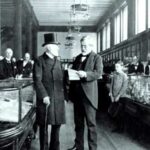How much was Richard Nixon worth?
| Net Worth: | $15 Million |
|---|---|
| Profession: | 37th U.S. President |
| Date of Birth: | January 9, 1913 |
| Country: | United States of America |
| Height: | 1.8 m |
About Richard Nixon
With an estimated net worth of $15 million, Richard Nixon was the 37th President of the United States, serving from 1969 to 1974. He was the first and only president to leave office due to his role in the Watergate campaign scandal.
- Dates: January 9, 1913 – April 22, 1994
- Also Known As: Richard Milhous Nixon, “Tricky Dick”
Being a Poor Quaker Growing Up
Francis “Frank” A. Nixon and Hannah Milhous Nixon welcomed a son, Nixon, on January 19, 1913 in Yorba Linda, California. When Nixon’s father’s ranch went down, he moved the family to Whittier, California, where he started a gas station and grocery shop. Nixon’s father had previously been a rancher.
Nixon was brought up in a deeply traditional Quaker home and experienced poverty as a child. Harold, Donald, Arthur, and Edward were the four brothers that Nixon had. (Harold passed away at age 23 from tuberculosis, and Arthur passed away at age 7 from tubercular encephalopathy.)
Nixon as Lawyer and Husband
Nixon was a standout student who received a scholarship to Duke University Law School in North Carolina after graduating second in his class at Whittier College. After earning his law degree from Duke in 1937, Nixon came back to Whittier where he practiced small-town law since he was unable to obtain employment on the East Coast.
Nixon and Thelma Catherine Patricia “Pat” Ryan first became acquainted while performing opposite one another in a local theater show. Tricia, who was born in 1946, and Julie, who was born in 1940, were their two children from their marriage (born in 1948).
World War II
The US entered World War II on December 7, 1941, when Japan attacked the US Naval facility at Pearl Harbor. Nixon and Pat soon relocated from Whittier to Washington, DC, where Nixon accepted a position with the Office of Price Administration (OPA).
Nixon qualified for a Quaker exemption from military service, but he preferred to join the US Navy instead since he was dissatisfied with his job at the OPA. He joined the US Navy in August 1942 at the age of 29. As a naval control officer, Nixon was assigned to the South Pacific Combat Air Transport.
Nixon received two service stars, a citation of recognition, and a promotion to the rank of lieutenant commander despite not participating in action during the war. In January 1946, Nixon gave his commission notice.
Nixon’s time in Congress
Nixon sought election to the House of Representatives in 1946 from California’s 12th Congressional District. Nixon utilized “smear tactics” to defeat Jerry Voorhis, a five-term Democratic incumbent, by implying that Voorhis was connected to the Communist Party due to the fact that Voorhis had previously received support from the labor movement’s CIO-PAC. Nixon prevailed in the vote.
Nixon’s anti-Communist crusade during his time in the House of Representatives was significant. Nixon was a member of the House Un-American Activities Committee (HUAC), which was in charge of looking into people and organizations with possible links to communism. Alger Hiss, a purported member of an underground Communist group, was investigated by him and later found guilty of perjury. Hiss was successfully convicted thanks in large part to Nixon’s tough interrogation of him during the HUAC hearing, which also made Nixon a household name.
Nixon ran for a Senate position in 1950. Nixon once more attacked Helen Douglas, his opponent, with smears. Nixon’s efforts to link Douglas to Communism were so blatant that he even had some of his flyers printed on pink paper. A Democratic committee ran a full-page advertisement with a political cartoon depicting Nixon stuffing hay labeled “Campaign Trickery” into a donkey labeled “Democrat” in several newspapers as retaliation to Nixon’s smear campaigns and attempts to persuade Democrats to vote for him across party lines. The caption “Look at Tricky Dick Nixon’s Republican Record” appeared beneath the image. He was still known as “Tricky Dick” Nixon managed to win the election despite the advertisement.
Election as vice president
In order to be the Republican Party’s nominee for president in 1952, Dwight D. Eisenhower needed a running mate. Nixon was a great choice for the job because of his anti-Communist stance and his broad support in California.
Nixon was accused of financial irregularities throughout the campaign, notably for utilizing a $18,000 campaign contribution for personal expenditures, and was almost booted off the ticket. Nixon defended his honesty and integrity in a televised statement on September 23, 1952, which came to be known as the “Checkers” speech. In a lighthearted moment, Nixon joked that he was just not going to return a small Cocker Spaniel dog that his 6-year-old daughter had called “Checkers.” The speech was a sufficient success for Nixon to remain on the ticket.
Richard Nixon, vice president
As vice president following Eisenhower’s victory in the presidential election in November 1952, Nixon gave international issues a lot of his attention. He traveled to various Far Eastern nations in 1953. He traveled to Africa in 1957 and to Latin America in 1958. Nixon also had a significant role in getting the 1957 Civil Rights Act passed by Congress.
Nixon and Nikita Khrushchev met in Moscow in 1959. In what came to be known as the “Kitchen Debate,” a spontaneous debate broke out on each country’s capacity to give its residents access to wholesome food and a fulfilling existence. The argument quickly became more obscene as both presidents defended their respective countries’ way of life. As their discussion over the possibility of nuclear war became more heated, Khrushchev warned of “very bad consequences.” Khrushchev declared his desire for “peace with all other nations, especially America,” perhaps sensing that the fight had gotten out of hand, to which Nixon retorted that he had not been “a very good host.”
President Eisenhower had heart attacks in 1955 and strokes in 1957, and Nixon was asked to take on some of the high-level responsibilities of the office. In the case of a presidential infirmity, there was no formal procedure in place at the time for the transfer of power. A deal negotiated by Nixon and Eisenhower served as the foundation for the 25th Amendment to the Constitution, which was approved on February 10, 1967. In the case of the President’s incapacity or death, the presidential succession is outlined in the 25th Amendment.
1960 presidential election failure
Nixon launched his own presidential campaign in 1960, following the conclusion of Eisenhower’s two terms in office, and he comfortably captured the Republican nomination. Senator John F. Kennedy of Massachusetts, his Democratic rival, ran on the platform of electing a new generation of leaders to the White House.
The first campaign to employ the new medium of television for commercials, news, and policy discussions was the 1960 election campaign. The first time in American history, the public has access to real-time coverage of the presidential race. In contrast to Kennedy’s younger and more attractive looks, Nixon chose to wear no makeup, a shoddy gray suit, and came across as looking old and worn during their first debate. Although the election was close throughout, Nixon ultimately fell short of Kennedy by just 120,000 votes.
Six Crises, a best-selling book that detailed Nixon’s involvement in six political crises, was written between 1960 and 1968 during the interim period. He also unsuccessfully challenged Democratic incumbent Pat Brown for governor of California.
The Election of 1968
President Kennedy was assassinated in Dallas, Texas, in November of 1963. In 1964, Vice President Lyndon B. Johnson took over as president and was easily re-elected. Nixon declared his own campaign in 1967 as the 1968 election drew near, comfortably capturing the Republican nomination. In the midst of the 1968 election, Johnson withdrew as a candidate due to rising disapproval ratings. Johnson’s resignation made Robert F. Kennedy, John’s younger brother, the new Democratic front-runner.
Robert Kennedy was shot and died on June 5, 1968, after winning the California primary. The Democratic Party quickly chose Hubert Humphrey, Johnson’s vice president, to run against Nixon in an effort to find a replacement. George Wallace, the governor of Alabama, entered the contest as an independent. Nixon won the presidency by 500,000 votes in another close election.
as President Nixon
As president, Nixon once more prioritized international relations. Nixon began by escalating the Vietnam War by launching a contentious bombing campaign against the neutral country of Cambodia in an effort to cut off North Vietnamese supply routes. He did, however, play a key role in the decision to remove all combatants from Vietnam, and by 1973, Nixon had ended conscription.
Nixon and his wife Pat visited China in 1972 with the assistance of Henry Kissinger, then secretary of state. It was the first time a US president had traveled to the communist country, which at the time was ruled by Mao Zedong, the leader of the Chinese Communist Party.
The Watergate Scandal
In what is regarded as one of the biggest landslides in American election history, Nixon was re-elected president in 1972. Regrettably, Nixon was prepared to resort to any methods to secure his reelection.
Five men were arrested breaking into the Democratic Party headquarters at the Watergate complex in Washington, D.C., on June 17, 1972, with the intention of installing listening devices. The Nixon campaign team anticipated that the gadgets would yield data that might be used to discredit Democratic presidential contender George McGovern. Although the Nixon administration first denied involvement in the break-in, Carl Bernstein and Bob Woodward, two young newspaper reporters for the Washington Post, got information from a source known as “Deep Throat,” who played a key role in connecting the administration to the break-in.
In a televised remark on November 17, 1973, Nixon famously said, “People have got to know whether or not their President is a crook.” Nixon remained defiant throughout the controversy. I mean, I’m not a criminal. Everything I have is something I earned.
Nixon had built a covert taping system in the White House, it was discovered during the subsequent investigation. Nixon grudgingly agreed to disclose 1,200 pages of transcripts from what became known as the “Watergate Tapes” after a legal battle. Unexpectedly, one of the cassettes had an 18 1/2 minute gap that a secretary said she had unintentionally erased.
Proceedings for Nixon’s impeachment and his resignation
The House Judiciary Committee started the impeachment process against Nixon when the tapes were made public. By a vote of 27 to 11, the Committee decided to submit articles of impeachment against Nixon on July 27, 1974.
Nixon gave his resignation address from the Oval Office on August 8, 1974, when he was facing impeachment and had lost the support of the Republican Party. Nixon was the first President in American history to resign from office when his resignation took effect at noon the next day.
Gerald R. Ford, Nixon’s vice president, was elected president. Nixon received a “full, free, and absolute pardon” from President Ford on September 8, 1974, effectively removing the possibility of an indictment against him.
Retirement and Death
After leaving office, Nixon moved to San Clemente, California, and retired. He wrote several works on international events in addition to his autobiography.
His public image was enhanced by the popularity of his books, which helped him establish himself as somewhat of an authority on American foreign policy. Nixon strongly advocated for American backing and financial assistance for Russia and other former Soviet nations as he neared the end of his life. Nixon had a stroke on April 18, 1994, and passed away at age 81 four days later. Richard Nixon’s total assets at the time of his passing were $15 million.



